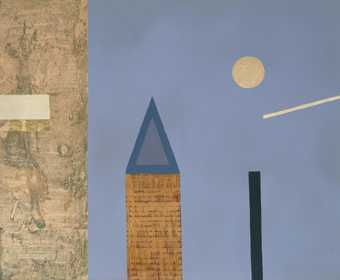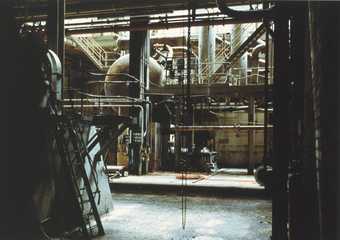Edward Platt on Stanley Spencer’s Turk’s Boatyard Cookham c1931
The last time I went to Cookham, the Thames had burst its banks. The road across Widbrook Common, where Spencer painted John Donne turning up in heaven, was closed, and the only way into the village was by train. Cookham Common, which the artist had re-imagined as the site of orgiastic encounters among villagers and others, had also flooded, but you could still get across it. The graves in the churchyard, from which the dead burst forth on the day of resurrection, weren’t under water, but parts of the towpath beside Turk’s Boatyard were.
Spencer painted the scene on mainly rainy days, and said ‘a rainy day’ might have been a subtitle for it, though it couldn’t have been as rainy as the day I was there: the Thames is still enough to hold the colours of the trees and reflections of the pillars of the bridge, though the gondola-like boats have climbed the bank and are pressing inwards, towards the viewer, as if lifted on a wave.
Spencer never painted Cookham in the flood – he would have seen it under water, as I had – but he didn’t fear the river or its power: his last, unfinished painting showed Christ preaching from a boat moored to the bank, and he saw the river as the ‘holy of holies’, which carried the daytrippers who came past on cruisers and pleasure boats into another realm. This calm, lucid painting gives a sense of how much he revered it.
Sasha Devas on Kenneth Rowntree’s Souvenir of Venice 1961

Kenneth Rowntree
Souvenir of Venice (1961)
Tate
I was 14 when I went to Venice for the first time. I was with my parents and we were staying in a vast apartment in a palazzo overlooking the Grand Canal and next to the Ca’ d’Oro. I met them there as I had travelled by train and they had flown. My train had wooden, slatted benches and no lavatory. At every station people left the train to have a pee, and at every station someone failed to make it back to their carriage.
Anyone arriving in Venice for the first time is hit by its beauty like a tsunami. Walking out of the station straight into a Canaletto is an unforgettable experience. That watery landscape is magical. We were sharing the apartment with my father’s elder brother Cedric and his family. He was a successful businessman running Reckitt & Colman in Rochester, New York – a real mustard king. He had a very glamorous American wife called Bunty and four children.
I was dazzled by their beauty and sophistication. I longed to be dressed in white organza party dresses all day like Prue and Vicky. We spent our days exploring the city while my father painted, and would meet up in the evenings to share wonderful meals next to the canal. We discovered the delights of the Locanda Montin and its fegato alla Veneziana and couldn’t stop ourselves from returning for more. We took a vaporetto to Torcello where a waiter handed me a pomegranate, and it was love at first sight.
Elain Harwood on Thomas Struth’s Bankside 5, London 1995 1995

Thomas Struth
Bankside 5, London 1995 (1995)
Tate
This image reminds me how I first saw inside Bankside Power Station in January 1993. It had twice been rejected for listing against the advice of English Heritage, and the Twentieth Century Society feared its demolition. Michael Hopkins offered to produce designs for its possible reuse, and we were in: Sir Michael, Alan Powers and Julian Holder from the society, and me.
There was a giant hall, glazed at each end like a cathedral, and to one side the biggest climbing frame you ever saw, with metal stairs threaded through thousands of pipes and leading open storey by open storey to the roof. ‘You can’t go up there,’ Michael proclaimed, so up we went. It was exhilarating just to stand on top of this icon, maligned when built for destroying the post-war vision of the South Bank as an arts and office area, and by the 1990s a land bank to fund developments by the nuclear power industry. Few people then appreciated the beauty of 1950s architecture, whether the continuing brick classicism of Bankside or an austere modernism bearing the spindly quirks of the Festival of Britain.
English Heritage subsequently commissioned reports from Alan, Julian and me that led to more buildings being listed (though not Bankside) and years later to a book. But another possible impact was made by Sir Michael and the engineer Alan Baxter when they suggested to Tate’s Nicholas Serota the possibilities of Bankside as an art gallery.
Wilhelm Sasnal on Lucio Fontana’s Spatial Concept ‘Waiting’ 1960
I’m surprised, looking very closely, that I can’t see the wall behind the slash in the canvas. Some obstacle, something black, has been put behind the hole. It’s not actually open. If you took this painting off the wall, the back would be blocked by this black linen, painted black. I have to say, I’m disappointed. I‘d always believed that there was a void in this work – a gap – and not reality. Instead, Fontana created black.
I remember a very famous Polish storybook from my childhood called Trzynaste piórko Eufemii (Eufemia’s Thirteenth Feather) from 1977, in which a group of creatures travel to other worlds through holes in the sky, meeting other non-human creatures. They invite us to walk through with them.
Since then, a hole in the sky is something that has always puzzled me. It’s not a negative, but something that attracts. As with a door, I’m always curious to see what’s behind it. Except I’m not expecting a person on the other side, but another dimension.
I’m always trying to imagine – and how to paint – what’s behind the canvas; how to get through it. To go through the canvas is always a call to another world, or to another reality. Maybe Fontana’s canvas is like a sky. You can see it as day and night – that behind the day, there is the night. And that’s why I’m disappointed that the work is blocked. Because there’s no way through.
